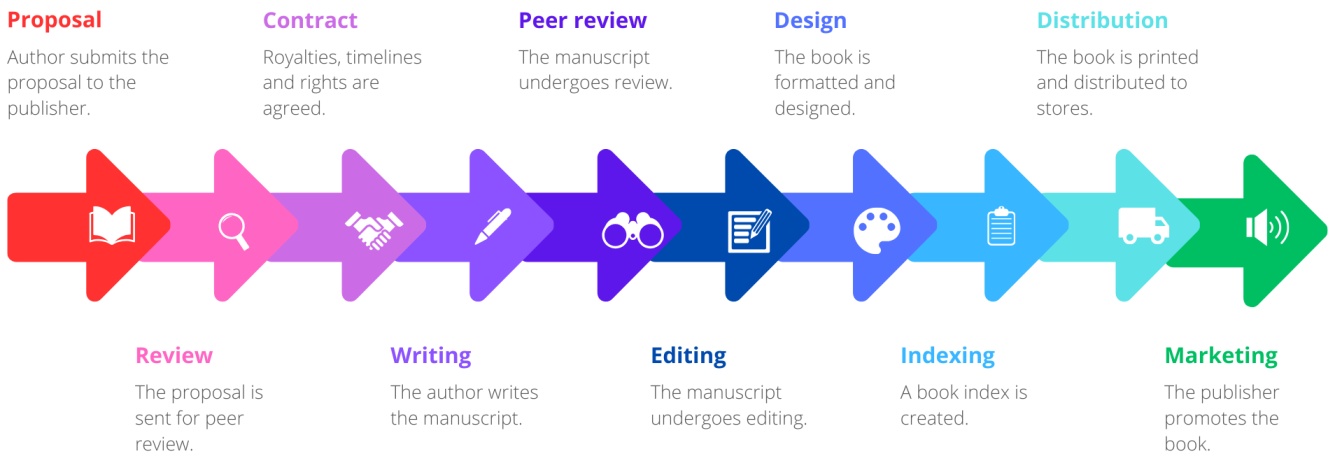Academic monographs are essential for disseminating specialised knowledge within scholarly communities. Authored by experts, these works provide in-depth analysis and original research on specific topics, advancing knowledge and fostering scholarly dialogue.
This guide outlines the publishing process, from proposal submission to post-publication promotion, and provides resources such as books, online tools and academic networks to support authors. Through careful planning and extensive research, authors can produce monographs that significantly contribute to their fields and enrich academic literature.
- What is an academic monograph?
- Considerations before writing an academic monograph
- Publishing an academic monograph
- Helpful resources for writing an academic monograph
What is an academic monograph?
An academic monograph is a detailed, scholarly work written by a single author or a small group of authors focusing on a specific topic or a narrow field of study. Unlike textbooks or general reference books, monographs present original research, in-depth analysis and comprehensive discussions on specialised subjects. Here are some key characteristics of academic monographs:
- Specialised focus: Monographs delve deeply into a particular subject, often presenting new research, theories or methodologies. They aim to advance knowledge in a specific field.
- Authorship: Typically authored by experts or scholars who have conducted extensive research on the topic. The work reflects their expertise and contributions to the academic community.
- Length: The length of an average academic monograph can vary depending on the field of study, the complexity of the topic and the specific requirements of the publisher. However, a typical academic monograph usually ranges from about 70,000 to 100,000 words. This is equivalent to approximately 200 to 300 pages when formatted and printed. Some monographs might be shorter, around 40,000 to 50,000 words, especially in humanities and social sciences. In contrast, others in more data-intensive or technical fields could be longer.
- Academic rigour: These works undergo a rigorous peer-review process to ensure the validity and reliability of the research. They adhere to high academic standards and are often published by academic or university presses.
- Intended audience: Primarily aimed at other scholars, researchers and advanced students in the field. They contribute to ongoing academic discussions and may be used as reference materials for further research.
- Contribution to the field: Monographs often significantly contribute to the academic discipline, offering new insights, perspectives or data that can influence future research and study.
Considerations before writing an academic monograph
Before writing an academic monograph, consider several factors to ensure your efforts are well-directed and that the final product is impactful and valuable.
Understanding the nature of writing a book
Books generally receive fewer citations than journal articles, as significant breakthroughs or new contributions to academic knowledge are often first presented in articles. Books tend to be more expensive, less accessible and frequently built on previously published material, such as earlier conference and journal articles or doctoral theses. Therefore, the decision to write a book should be driven by a strong and clear rationale.
Assessing the time and effort required
Writing a monograph requires substantial time and effort. It involves extensive research and reading on the chosen topic. While completing a PhD typically takes 5–8 years, even experienced academics might spend at least a year writing a monograph, drawing on years of prior research and expertise.
Transforming a doctoral thesis into a monograph
Converting a PhD thesis into a book can be time-consuming, depending on the structure of the original thesis. Traditional PhDs often include extensive literature reviews, which may need to be condensed or modified for a broader audience more interested in new themes, cases, findings and arguments than in exhaustive literature reviews.
Selecting a suitable publisher
Finding the right academic publisher is crucial. You need to identify publishers that have published similar works or have an established collection that your book could complement. Writing a compelling book proposal is essential; it should detail how your book will contribute to the academic field and align with the publisher’s goals. Preliminary research will help you understand how to structure and organise your writing to meet both academic standards and publisher requirements.
Additional considerations
- Audience identification: Clearly define who the intended audience is. This will help tailor your monograph’s content, style and presentation to meet their expectations and needs.
- Funding and resources: Ensure you have the necessary funding and resources, such as access to research materials, time for writing, software and tools and support from colleagues or mentors.
- Publication timeline: Develop a realistic timeline for writing, revising and publishing the monograph, accounting for potential delays.
- Peer feedback: Seek feedback from peers and mentors throughout the writing process to refine your arguments and improve the overall quality of the work.
- Marketing and promotion: Once published, consider how you will market and promote your monograph. Collaborating with the publisher on promotional strategies can increase the book’s visibility and impact.
Publishing an academic monograph
Publishing an academic monograph involves several steps, from initial concept to final distribution. Here is an overview of the key stages in this process:
1. Proposal and initial submission
- Identifying a publisher: Research potential publishers that specialise in your field. Look for those with a catalogue that aligns with your topic and approach.
- Preparing a proposal: Write a detailed book proposal, including a summary, chapter outline, target audience, market analysis and sample chapters. Explain how your work contributes to the academic field and fits within the publisher’s existing catalogue.
- Submission: Submit your proposal to the selected publishers. This may involve direct submission or through an academic agent.
2. Review and contract
- Peer review: The publisher sends your proposal and sample chapters to experts in the field for peer review. This stage ensures the scholarly value and quality of the work.
- Revisions: Based on reviewer feedback, you may need to revise your proposal or sample chapters.
- Contract offer: If the publisher is satisfied with the reviews and revisions, they will offer you a publishing contract outlining the terms and conditions, including royalties, deadlines and rights.
3. Manuscript preparation
- Writing: Complete the manuscript according to the agreed timeline. This involves thorough research, writing and initial self-editing.
- Submission: Submit the complete manuscript to the publisher for review.
4. Production
- Copyediting: A professional copyeditor reviews the manuscript for grammar, style, consistency and clarity. This stage involves close collaboration between the author and the copyeditor to address any queries or changes.
- Typesetting and design: The manuscript is formatted according to the publisher’s design standards. This includes layout, fonts, headings and any illustrations or tables.
- Proofreading: After typesetting, the manuscript is proofread to catch any remaining errors or formatting issues. This is typically the last chance to make corrections before printing.
- Indexing: A professional indexer creates an index for the book, which is crucial for accessibility and usability, especially in academic works.

5. Printing and distribution
- Printing: The book goes to print once the final proof is approved. The publisher may offer both hardcopy and digital formats.
- Distribution: The publisher handles distribution to libraries, bookstores and online platforms. They also manage inventory and sales logistics.
6. Marketing and promotion
- Promotion: Collaborate with the publisher on a marketing plan. This may include book launches, academic conferences, social media campaigns and promotional copies sent to reviewers.
- Sales and distribution: The publisher oversees the sales process, distribution channels and royalty payments to the author.
7. Post-publication
- Continuous marketing: Ongoing promotion to keep the book relevant in the academic community.
- Feedback and reviews: Collect and respond to feedback and reviews, which can enhance the book’s reputation and influence.
Helpful resources for writing an academic monograph
Writing an academic monograph is a challenging and rewarding process that requires careful planning, extensive research and meticulous writing. Here are some resources that can help you through various stages of writing and publishing your monograph:
Books and guides
- The Craft of Research by Wayne C. Booth, Gregory G. Colomb and Joseph M. Williams provides insights into research methods and writing techniques essential for academic writing.
- The Dissertation-to-Book Workbook by Katelyn E. Knox and Allison Van Deventer offers a series of manageable, concrete steps with exercises to help you revise your academic manuscript into publishable book form.
- How to Write a Book Proposal by Jody Rein and Michael Larsen is a comprehensive guide on writing compelling book proposals that can attract publishers.
- Writing Successful Academic Books by Anthony Haynes, Charles B. Harris and Ben Jonson is a practical guide that covers various aspects of writing and publishing academic books.
Online resources
- Academic Book Titles: How to title your monograph titles based on the quantitative data extrapolates more accessible monograph title suggestions
- Cambridge University Press Author Hub offers resources for authors preparing, writing and publishing academic books.
- Purdue Online Writing Lab (OWL) offers a wealth of resources on academic writing, including grammar, style and formatting guidelines.
- The Scholarly Kitchen is a blog by the Society for Scholarly Publishing offering insights into the academic publishing industry.
- Writing Center at the University of North Carolina at Chapel Hill provides handouts and videos on various aspects of academic writing and publishing.
Software and tools
- EndNote is a reference management software that simplifies referencing and creating bibliographies.
- Grammarly is a writing assistant that helps with grammar, style and punctuation.
- Hemingway is a powerful writing software that helps organise and manage large writing projects like monographs.
- Zotero is a free reference management tool to help you collect, organise, cite and share research.
Academic networks and communities
- Academia.edu is a platform for academics to share research papers and follow the work of others in their field.
- ResearchGate is a social networking site for scientists and researchers to share papers, ask and answer questions and find collaborators.
Workshops and courses
- Coursera offers various courses on academic writing and research methods.
- edX provides online courses on writing and publishing in academia.
- Future Learn offers online courses, micro credentials and degrees from universities.
Key takeaways
In conclusion, academic monographs are detailed, scholarly works authored by experts focusing on specific topics to present original research and in-depth analysis. They explore particular fields, presenting new theories and methodologies. They undergo rigorous peer review to ensure high academic standards and target scholars, researchers and advanced students, aiming to contribute significant insights and data to academic discussions.
Writing a monograph requires understanding the nature of book writing, the substantial time and effort involved and potentially transforming a doctoral thesis into a monograph. Selecting a suitable publisher, identifying the target audience, securing the necessary funding and developing a realistic timeline are crucial steps in creating an impactful and valuable monograph.
I am an editor and indexer working with academic writers, preparing their texts for publication in academic journals and presses. If your academic manuscript needs a second pair of eyes, contact me for a free sample edit (and remember to use my early bird discount).


